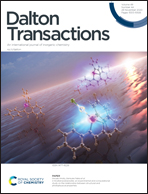Preferential phonon scattering and low energy carrier filtering by interfaces of in situ formed InSb nanoprecipitates and GaSb nanoinclusions for enhanced thermoelectric performance of In0.2Co4Sb12†
Abstract
Filling the voids of cage forming compounds with loosely bound electropositive elements and by incorporating nano-sized secondary phases are promising approaches to enhance the thermoelectric figure of merit of these materials. Hence, in this work, by combining these two approaches—inserting In into the voids of skutterudite Co4Sb12 as well as dispersing nanoparticles (GaSb)—we have synthesized various samples via ball-milling and spark plasma sintering. InSb as the secondary phase of the matrix, mixed with GaSb, forms the solid solution Ga1−xInxSb. Nanocrystalline grains together with a few larger grains (10–30 μm) are found to be spread in In0.2Co4Sb12. The former is comprised of either InSb, GaSb or Ga1−xInxSb. Because of their identical space group and similar lattice parameters, InSb, GaSb and Ga1−xInxSb could not be detected separately in EBSD. High resolution transmission electron microscopy (HRTEM) was used to resolve different phases, which showed GaSb grains of size ∼10–30 nm and InSb grains of size ∼30–100 nm. Scattering of charge carriers at the interfaces of InSb, GaSb and Ga1−xInxSb as well as the matrix phases increased both the electrical resistivity and Seebeck coefficient. The multi-scale size distribution of grains, of both the matrix phase and the secondary phases, scattered phonons within a broad wavelength range, resulting in very low lattice thermal conductivities. As a result, an enhanced figure of merit of 1.4 was achieved for the (GaSb)0.1 + In0.2Co4Sb12 nanocomposite at 773 K.



 Please wait while we load your content...
Please wait while we load your content...